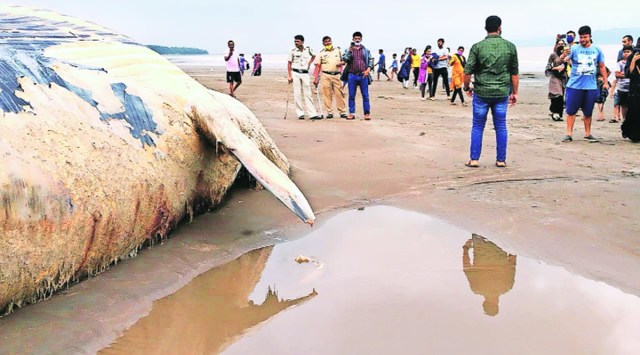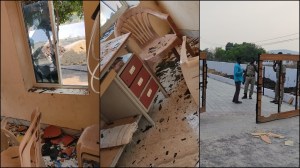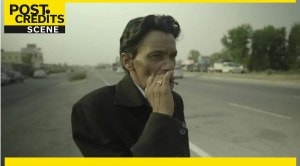- India
- International
Mumbai: Bryde whale washes ashore beach in Vasai, buried after mammoth 24-hr effort
According to a local, over 15 people from the state forest and local disaster management department and volunteers were involved in the task of burying the whale. Experts assessed that the whale had died before being washed ashore.
 Experts assessed that the whale had died before being washed ashore. (Express Photo)
Experts assessed that the whale had died before being washed ashore. (Express Photo)Following massive effort and brainstorming on the part of authorities as well as locals, and amid challenges such as intermittent rainfall, the carcass of a 43-feet suspected Bryde’s whale, which was washed ashore Rangaon beach in Vasai on Tuesday afternoon, was buried at the beach late on Wednesday evening, forest department officials said.
The carcass of the whale was spotted on Tuesday but efforts to remove the carcass could only be initiated the next morning due to rainfall, they added.
The officials first decided to take the carcass away, but after a JCB machine was stuck twice on the sandy beach, they decided to bury the animal on the spot by digging a five-feet deep pit late on Wednesday– nearly 24 hours after it was found.
According to a local, over 15 people from the state forest and local disaster management department and volunteers were involved in the task of burying the whale.
“The digging of the pit was interrupted many times throughout the day because of the rainfall. In addition, the carcass was within the high-tide line, making it inaccessible during the high tide on Wednesday afternoon. The water had also gushed inside the pit, forcing us to restart the work. We had started digging the pit at 8am but the work was completed only by Wednesday evening,” said one of the staffers.

Experts assessed that the whale had died before being washed ashore.
Bryde’s whale is a tropical mammal usually found in warmer waters of the Pacific, Indian and Atlantic oceans. India, so far, has not undertaken much research on the species.
Last year, in January, the carcass of a 57-feet Bryde’s whale had washed ashore Murud beach in Ratnagiri; that whale too was buried at the site.
The state forest department collected tissue samples from a decomposed carcass of a whale for DNA analysis, which, researchers said, will reveal the gender and confirm its species.
“The whale was lying upside down and we could not move it to assess what species it was. Dependent on the measurements, morphology and blade count, we have assessed it to be Bryde’s whale. I have also asked the staffers to click detailed pictures for better assessment and to understand the injuries, if any, that was sustained by the cetacean,” said Harshal Karve, marine biologist with the Mangrove Foundation.
While the cause of the mammal’s death could not be ascertained, experts suspect that rise in shipping activity, being hit by trawlers, plastic pollution, fishing hooks in small mammals, among other reasons, could have led to the deaths of some marine animals. The carcasses get washed ashore in monsoon because the wind speed is strong at that time, they added.
“The carcass of the whale was intact; however, it was in an advanced state of decomposition because of which postmortem was not possible. It was in a putrefied state and opening up the carcass was not recommended due to health risks,” Karve added.
The authorities and volunteers also had a tough time keeping locals away from the area, which was cordoned off by a rope. Forest department officials had to explain to the crowd that inhaling the air filled with bacteria of the whale’s remains could be harmful, they said.
Experts said the buoyancy of the carcass, current flow, wind flow and tide are among factors that could be behind the spotting of the whale carcasses in the region.
Instances of cetacean stranding in the state have been recorded on the south Konkan coast, especially in Ratnagiri district. Cetacean stranding, commonly known as beaching, is a phenomenon in which whales and dolphins, among others, get stranded on land, usually on a beach.
While carcasses of several marine animals, including dolphins, porpoises, turtles and whales, have been found along the Konkan coast, the cause of their death has mostly remained unclear. In most cases, by the time the forest department responds to the incident, the animal’s body is already decomposed, which makes post mortem impossible.
Karve further said, “Checking for external injuries and conducting an autopsy of the whale is not an easy job because of the sheer size of the cetacean. We conduct external morphological analysis as part of which we take photos of the carcass from the dorsal side to check if the animal had been starving for a long period. However, in this particular case, when it was not lying on the dorsal side, morphological analysis is also not possible.”
In absence of a standard operating procedure (SOP) for beaching/stranding of the cetacean, decisions to move the dead body or burying are taken by the veterinarian or range forest officers present at the site. “There is no SOP stating the depth of the pit or steps to complete the process. In almost all cases of stranding of the whales, they are buried on the beach itself,” said Neenu Somraj, deputy conservator of forests, Maharashtra Mangrove foundation.
Notably, the state forest department has recently begun a five-year study to enquire and investigate cases of beaching across Maharashtra’s coastline.
Apr 18: Latest News
- 01
- 02
- 03
- 04
- 05






































